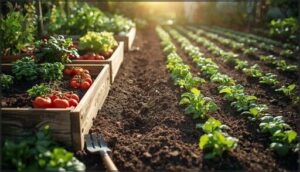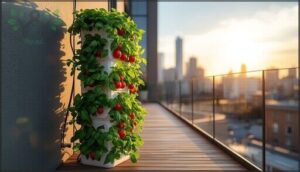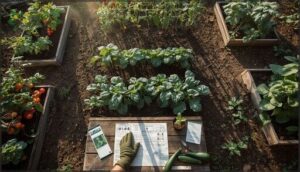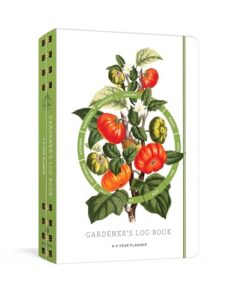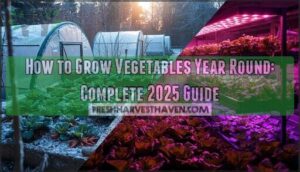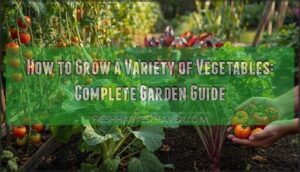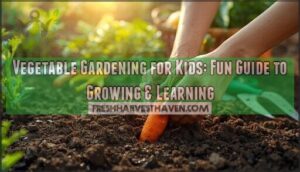This site is supported by our readers. We may earn a commission, at no cost to you, if you purchase through links.
Your first vegetable garden might produce three tomatoes and a handful of wilted lettuce—or it could fill your kitchen with fresh produce for months. The difference comes down to planning.
Most gardeners jump straight to planting without considering sunlight patterns, soil preparation, or which crops actually thrive together. They end up fighting weeds, battling pests, and wondering why their neighbors harvest bushels while they get scraps.
Smart vegetable garden planning tips change everything. When you map out your space, match crops to your climate, and prepare your soil properly, you set yourself up for abundant harvests instead of disappointing failures.
Table Of Contents
- Key Takeaways
- Why Planning Your Vegetable Garden Matters
- Choosing The Best Garden Location
- Designing Your Vegetable Garden Layout
- Selecting and Arranging Your Vegetables
- Top 3 Tools for Vegetable Garden Planning
- Preparing and Managing Your Garden Soil
- Maintaining Your Garden for Maximum Harvest
- Frequently Asked Questions (FAQs)
- How do you plan a vegetable garden?
- Do you need help planning a vegetable garden layout?
- What are the different layouts for vegetable gardens?
- What should you do before planting in your vegetable garden?
- What should I consider when creating a new vegetable garden?
- How to plan for long-term vegetable gardening?
- How much water do vegetables need daily?
- When should I start seeds indoors?
- What tools are essential for vegetable gardening?
- How do I prevent common garden diseases?
- Conclusion
Key Takeaways
- Planning your garden layout before planting—including sunlight mapping, soil testing, and proper spacing—can increase yields by up to 850 pounds annually in a 400-square-foot space while cutting maintenance time by 30%.
- Strategic crop rotation every three to five years starves soilborne pathogens and boosts soil microbes by 21%, while companion planting like tomatoes with basil cuts pest damage by over 70% without chemicals.
- Succession planting every 10 days and intensive methods like square-foot gardening or vertical systems let you harvest continuously and fit three crops per year in the same bed, doubling yields compared to traditional rows.
- Proper watering (1–1.5 inches weekly via drip irrigation) and organic soil practices like composting and mulching improve water retention by 50%, suppress weeds by 63%, and can return eight to nine dollars for every dollar you invest.
Why Planning Your Vegetable Garden Matters
Planning your vegetable garden before you plant isn’t just a nice idea—it’s the difference between a thriving harvest and a frustrating mess.
When you map out your space, choose the right crops, and think through your layout, you set yourself up for success from day one.
Here’s why a little time spent planning now pays off all season long.
Increased Yield and Efficient Space Use
When you plan your vegetable garden properly, you’ll be surprised how much food fits in a small space. Smart spacing and crop density decisions directly impact your harvest size.
- A well-maintained 400-square-foot garden can produce over 850 pounds of vegetables annually through space optimization
- Intensive block planting methods yield 0.75 pounds per square foot versus conventional rows at 0.60 pounds
- Vertical systems boost garden yields in tight spots, achieving up to 44 pounds per square meter
Effective garden planning involves considering soil health matters to secure peak growth.
Reduced Pests and Disease Risks
Strategic garden planning is your first defense against pests and disease. Crop rotation every three to five years starves soilborne pathogens that target tomatoes and potatoes, while companion planting shifts soil microbes toward disease-suppressive communities.
Proper plant spacing improves air circulation, helping foliage dry faster to prevent fungal outbreaks. These biological control tactics reduce your need for chemical interventions while protecting soil health naturally.
Effective crop rotation methods can also contribute to maintaining healthy soil and maximizing yields.
Better Organization and Maintenance
A structured garden layout cuts your maintenance time by up to 30%. Install 45-cm-wide paths between beds so you won’t compact soil during routine tasks. Group crops with similar watering needs in dedicated zones to simplify irrigation and reduce water use by 20–40%.
Weekly maintenance routines—spot-checking pests, weeding beds, and tidying debris—prevent seasonal backlogs and keep your vegetable garden design manageable year-round.
Choosing The Best Garden Location
Your garden’s location can make or break your harvest before you even plant a single seed. The right spot gives your vegetables what they need to thrive, while the wrong one sets you up for an uphill battle all season long.
Your garden’s location can make or break your harvest before you even plant a single seed
Here’s what you need to look for when scouting your yard.
Sunlight and Shade Considerations
Your vegetables need the right amount of sunlight to thrive—most fruiting crops demand 8–10 hours of daily sun, while leafy greens and root vegetables tolerate 4–6 hours in partial shade. Pay attention to microclimate effects from nearby trees and structures that block light throughout the day.
Here’s how to match crops to your garden’s sun exposure:
- Tomatoes and peppers: 8–10 hours direct sunlight
- Lettuce and spinach: 4–6 hours minimum
- Carrots and beets: 6–8 hours preferred
- Corn and melons: full sun all day
- Shade gardening options: arugula, Swiss chard
Position tall plants on the north side so they won’t cast unwanted shade. Consider UV radiation intensity in your garden layout—some leafy crops benefit from afternoon shade cloth during peak summer heat. Observe your site across seasons, because sun patterns shift as trees leaf out and the angle changes from spring through fall.
Water Access and Drainage Needs
Without convenient water access, you’ll struggle to maintain the 1–2 inches per week most vegetables demand. Position beds within easy hose reach or plan drip irrigation for water efficiency—it delivers moisture directly to soil around roots while cutting evaporation losses.
Verify proper drainage systems by testing soil moisture; standing water invites root rot and disease. Good garden layout balances consistent watering with adequate soil preparation to prevent waterlogged conditions.
Protection From Wind and Wildlife
High winds can snap stems and strip moisture from shallow-rooted crops, cutting yields by up to 30%. Windbreak designs—hedges or fencing placed perpendicular to prevailing gusts—shield beds for distances reaching twenty times their height.
Wildlife fencing seven to eight feet tall stops deer browsing, while row covers and netting systems exclude rabbits and birds. Integrate pest barriers early in your garden planning to protect vertical gardening setups and companion planting schemes.
Designing Your Vegetable Garden Layout
Your garden layout can make or break your harvest. The right design helps you fit more plants into less space, keeps maintenance simple, and sets you up for steady yields all season long.
Let’s walk through the main layout options so you can choose what works best for your growing conditions.
Raised Beds Vs. In-Ground Rows
Choosing between a raised bed and in-ground rows shapes your entire garden layout. Raised beds offer better soil depth control and drainage systems, letting you customize bed materials for maximum crop yields. They boost space efficiency and simplify crop rotation while reducing back strain.
In-ground rows cost less upfront but may need more soil prep. For vegetable gardening, raised beds usually deliver better results with less maintenance.
Square-Foot and Block Planting Methods
Optimize every inch of your plot with square-foot and block planting methods. These intensive planting strategies pack more vegetables into smaller areas—often doubling yields compared to traditional rows. Here’s how to make it work:
- Divide beds into 1-foot squares: Place 1–16 plants per square depending on size
- Focus on plant spacing, not row spacing: Reduce gaps by 25–60%
- Let mature leaves just touch: This shades out weeds naturally
Dense crop density improves soil optimization and water efficiency while simplifying your vegetable garden layout.
Vertical Gardening for Small Spaces
Running out of ground? Go up. Vertical towers and hydroponic systems let you stack dozens of plants in just a few square feet—perfect for urban farming and small space designs.
You’ll see 3–5 times more yield per square foot compared to traditional vegetable gardening, and water use drops by up to 95%. This container gardening approach transforms your vertical garden into a productive powerhouse without expanding your footprint.
Plant Spacing and Crop Arrangement
Spacing determines how well your garden breathes. When you plant tomatoes 24–36 inches apart and use north–south row spacing, sunlight reaches every leaf and air moves freely through the canopy.
Block planting and intercropping—like pairing onions with mustard—improve crop density while cutting pest pressure.
Tight spacing boosts yield per square foot, but soil optimization and consistent watering keep competition from choking your harvest.
Selecting and Arranging Your Vegetables
Once your layout is ready, it’s time to decide what you’ll actually grow. The vegetables you choose and how you arrange them will shape your garden’s success from day one.
Let’s walk through the key decisions that’ll help you pick the right crops and set them up to thrive together.
Choosing Crops for Your Climate
Your local climate zone shapes every crop decision you make. Start by checking your Plant Hardiness Zone—it tells you which vegetables can actually survive your winters.
Cool-season crops like lettuce tolerate light frosts, while heat-tolerant tomatoes need warm soil temperatures above 60°F.
Match frost dates to planting windows, and you’ll avoid heartbreak when surprise freezes hit your garden.
Companion Planting Strategies
Once you know what grows in your zone, pair plants that help each other thrive. Tomatoes and basil make a classic duo—basil reduces hornworm damage by more than 70% while drawing in helpful parasitoid insects.
Plant onions near carrots to confuse carrot flies, or add marigolds beside tomatoes to slash fruit borer infestation and boost yields by 14%.
Succession Planting for Continuous Harvest
Succession planting keeps your harvest flowing week after week instead of overwhelming you with a single glut. Plant lettuce or radishes every ten days so the next batch matures as you finish the first.
Use pull-and-replace crop rotation—when early greens fade, drop in beans or cucumbers.
Scheduling your planting around harvest windows and seasonal planning turns one bed into three crops per year, boosting continuous yield without extra space.
Starting From Seeds or Transplants
Starting from seeds or transplants shapes your planting schedule and harvest timing. Seeds cost pennies per plant but need weeks indoors under lights, while transplants run several dollars each and skip seed germination hassles.
Long-season crops like tomatoes and peppers benefit from transplant shock prevention through hardening, whereas quick growers—radishes, beans—thrive direct-sown, fitting neatly into your crop rotation without extra soil preparation steps.
Top 3 Tools for Vegetable Garden Planning
You don’t need fancy equipment to plan a successful vegetable garden, but the right tools can make the process smoother and help you stay organized throughout the season. From keeping your plants hydrated to tracking what works year after year, a few well-chosen resources will save you time and guesswork.
Here are three practical tools that can strengthen your garden planning from the start.
1. Gilmour Flat Soaker Garden Hose
Getting water to your vegetable roots without waste is where the Gilmour Flat Soaker Garden Hose earns its keep in garden planning. This 25- or 50-foot hose seeps moisture directly into the soil along raised beds or in-ground rows, cutting water use nearly in half compared to sprinklers while keeping soil moisture steady.
It’s lightweight, lies flat against your garden layout, and delivers drip irrigation benefits without complicated setup—ideal for conserving water and supporting healthy vegetable growth in tight spaces.
Best For: Vegetable gardeners who want to cut water waste while delivering consistent moisture to raised beds or row plantings without fussing over drip line assembly.
- Seeps water directly to roots with minimal evaporation or runoff, reducing overall garden water use by up to 50% compared to sprinklers.
- Lightweight flat design lies flush against soil, fits between tight rows, and rolls up easily for off-season storage.
- Backed by a lifetime warranty and made from clog-resistant fabric over recycled vinyl, offering durability without the cost or complexity of permanent drip systems.
- Can spring leaks at seams or fail after 2–3 seasons if water pressure exceeds the 60 PSI limit or hose experiences rough handling.
- Ridged construction makes sharp turns difficult, limiting flexibility in curved beds or irregular garden layouts.
- Requires about 200 minutes of run time to deliver 1 inch of water, which demands careful scheduling and may not suit gardeners needing rapid irrigation.
2. Organic Vegetable Container Gardening Guide
When balcony space or a cramped patio replaces your dream yard, container gardening transforms what you’ve got into a productive vegetable plot. This organic guide covers container size essentials—20 inches for tomatoes, 14 for peppers—and walks you through soil mix formulas combining peat, compost, and perlite for water conservation and drainage.
You’ll learn vertical gardening techniques, crop rotation strategies, and small space gardening layouts that boost yield. Practical vegetable gardening tips keep your container garden thriving organically, even when you’re working with nothing but a sunny corner and determination.
Best For: Urban dwellers and apartment gardeners who want to grow organic vegetables in small spaces like balconies or patios without a traditional yard.
- Delivers practical space-saving techniques including vertical growth, intercropping, and closely planted beds that maximize yield in containers as small as 14 inches
- Uses organic and biodynamic methods with detailed soilless mix recipes and natural fertilizer alternatives, eliminating synthetic chemicals while maintaining healthy plant growth
- Offers strong economic value with container tomatoes costing around $0.25 per pound and peppers about $0.10 per pound compared to store prices of $1.77 and $2.37 respectively
- Physical book quality disappoints some readers with newsprint-style pages, lack of photos, and lightweight construction that feels cheap for the price
- Experienced gardeners may find the content repetitive or too basic, especially if they’re already familiar with standard container growing practices
- Charts and illustrations can be confusing or unclear, making it harder to follow certain technical guidance on spacing and plant rotation
3. Gardener Five Year Log Book
Track your vegetable garden’s progress across five seasons with a waterproof log book that turns guesswork into data. You’ll map 12-month bloom and harvest grids, record first frost dates, and compare yields year over year—spotting which beds produced the most and which varieties flopped.
Gridded pages let you diagram crop rotations and plant spacing, while lined sections capture soil amendments and pest observations. This garden journal transforms scattered notes into organized recordkeeping that sharpens your planning, optimizes yields, and builds a customized playbook for your climate and conditions.
Best For: Vegetable gardeners who want to track yields, refine crop rotations, and build a multi-year record of what works in their specific climate and soil.
- Five-year grids let you compare frost dates, bloom times, and harvests side by side, making it easier to spot patterns and adjust your planting schedule each season.
- Gridded pages for bed layouts and lined sections for notes keep crop rotations, pest logs, and soil amendments organized in one waterproof, field-ready book.
- Built-in appendices on composting, pruning, and pest control give you quick reference guides right alongside your planting records.
- Some gardeners find the pages too small for large or complex gardens, with tight gridded space that makes detailed bed diagrams difficult.
- The binding may not hold up for the full five years of use, especially with frequent outdoor handling in wet or muddy conditions.
- Seasonal organization instead of year-by-year layout can feel limiting if you prefer to review or compare entire growing seasons at a glance.
Preparing and Managing Your Garden Soil
Your garden soil is the foundation of everything you’ll grow, so getting it right from the start makes all the difference. Healthy soil feeds your plants, holds moisture where roots need it, and helps prevent many common problems before they start.
Here are three essential practices that’ll keep your soil in top shape season after season.
Composting and Mulching Techniques
You can turn kitchen scraps and yard waste into rich compost that feeds your soil and cuts down on landfill methane—redirecting half of U.S. food waste could save 64 million tons of CO₂ annually.
Apply compost at one ton per acre to boost organic matter by about 10%, improving water retention and nutrient availability.
Spread organic mulch 1–3 inches deep to suppress weeds, conserve moisture, and regulate soil temperature throughout the growing season.
Crop Rotation for Soil Health
Rotate your crops each season—planting different families where last year’s tomatoes or beans grew breaks pest cycles and rebuilds soil. Legumes add nitrogen naturally, while diverse rotations boost soil microbes by 21% and increase carbon sequestration by 3.6%. You’ll see yields jump up to 20% compared to planting the same vegetables in the same spots year after year.
Fertilizing and Watering Best Practices
Your plants thrive when you match water and nutrients to their real needs. Most vegetables need 1 to 1.5 inches of water weekly—about 62 gallons per 100 square feet—split into two or three sessions rather than one heavy soak.
- Apply 10 pounds of 10-10-10 fertilizer per 1,000 square feet, or switch to blood meal when soil tests show excess phosphorus
- Install drip irrigation to cut water use by 50% while boosting efficiency to 90%
- Water when the top 1 to 2 inches of soil feel dry, not on a fixed schedule
Maintaining Your Garden for Maximum Harvest
Your garden won’t take care of itself once everything’s in the ground. You’ll need to stay on top of weeds, pests, and plant support to keep your harvest on track.
Here’s what you should focus on to get the most out of your growing season.
Controlling Weeds and Pests Organically
You can cut weed pressure dramatically without chemicals. Wheat straw mulch benefits your beds by blocking up to 63% of weed growth while keeping moisture in. For faster results, flame weeding knocks out 64–92% of seedlings before crops emerge.
Row covers stop pests cold—zucchini under covers saw zero whiteflies. Trap cropping draws bugs to border plants, slashing damage by 95%. Pair these with companion planting and organic pesticides like neem oil for complete organic pest control.
Pruning and Supporting Your Plants
Once weeds and pests are handled, proper pruning techniques and plant staking take over. Pruning opens your garden canopy, slashing powdery mildew risk in cucumbers while improving airflow.
Tomatoes on single-string vertical support can yield over 100 tons per hectare—that’s serious output. Trellised melons outyield ground-grown by 73% and produce firmer, sweeter fruit.
Supporting your crops isn’t optional—it’s how you attain peak plant health and make the most of every square foot.
When and How to Harvest
Harvest timing separates great yields from waste. Bush beans deliver in 50–60 days, tomatoes in 60–85. Pick cucumbers while dark green—yellowing means you’re late. Morning harvests lock in crispness before heat kicks respiration into overdrive.
- Overripe vegetables lose sweetness permanently as sugars convert to starch
- Frequent small harvests keep plants producing all season long
- Clean, sharp tools prevent bruising that invites disease
- Rapid cooling below 40°F stops spoilage and extends storage life
Yield optimization starts when you know exactly when to cut.
Frequently Asked Questions (FAQs)
How do you plan a vegetable garden?
A well-planned vegetable garden can return eight to nine dollars for every dollar invested.
Start with garden mapping your space, then conduct soil testing, choose your garden layout, plan crop rotation, and establish irrigation systems and garden budgeting.
Do you need help planning a vegetable garden layout?
You don’t need help if you follow a clear process: choose your location, test the soil, map your space, select crops that fit your climate, and arrange plants for ideal sunlight and growth.
What are the different layouts for vegetable gardens?
You can choose traditional rows, raised beds, square foot gardening, vertical gardening for small spaces, keyhole gardens for accessibility, or container layouts. Each garden design suits different yards and goals.
What should you do before planting in your vegetable garden?
Before planting your garden, start with soil testing to reveal nutrient levels.
Then, focus on site preparation by choosing the right location with proper drainage and sunlight for selecting vegetables suited to your climate zone.
What should I consider when creating a new vegetable garden?
Start with sunlight—your crops need at least six hours daily.
Test your soil’s pH and drainage, map your garden layout carefully, plan crop rotation paths, and locate a reliable water source nearby for irrigation.
How to plan for long-term vegetable gardening?
Many gardeners believe crop rotation is optional, but research proves otherwise: planting tomatoes in the same spot raises disease from 3% to 74% by year three.
Long-term success demands garden mapping, soil testing, and seasonal planning.
How much water do vegetables need daily?
Most vegetables need about one to one-and-a-half inches of water per week—roughly nine to thirteen gallons per hundred square feet daily. Hot weather, sandy soil, and containers increase those watering demands markedly.
When should I start seeds indoors?
Your seed starting schedule depends on your local frost dates and crop type. Most vegetables need indoor sowing 4–8 weeks before your last spring frost, with brassicas requiring 10–12 weeks and tomatoes about 6–8 weeks.
What tools are essential for vegetable gardening?
You’ll need hand trowels for transplanting, pruning shears for trimming, garden hoes for weeding, a wheelbarrow for hauling soil and compost, and a hori hori knife for precise planting depth measurements.
How do I prevent common garden diseases?
Start with disease-resistant varieties and rotate crops every three years to cut soil-borne pathogens by up to 60%.
Use mulch, drip irrigation, and prompt removal of infected plants for effective organic pest control.
Conclusion
Victory gardens didn’t just appear—they succeeded because people planned them carefully. Your garden works the same way.
These vegetable garden planning tips give you control over layout, soil quality, and crop choices so you harvest more and struggle less. Map your space before you plant. Build healthy soil from the start. Choose vegetables that fit your climate.
You’ll transform empty ground into steady harvests that fill your table all season long.
- https://gardenbetty.com/how-much-to-plant-in-a-vegetable-garden-to-feed-a-family/
- https://pmc.ncbi.nlm.nih.gov/articles/PMC6372235/
- https://www.vegetableacademy.com/post/how-plant-spacing-affects-yield-and-fruit-size-in-vegetable-gardens
- https://fieldreport.caes.uga.edu/publications/C1027-3/raised-beds-vs-in-ground-gardens/
- https://www.ecolandscaping.org/11/designing-ecological-landscapes/edible-landscaping/incorporating-vegetables-into-the-urban-landscape/



